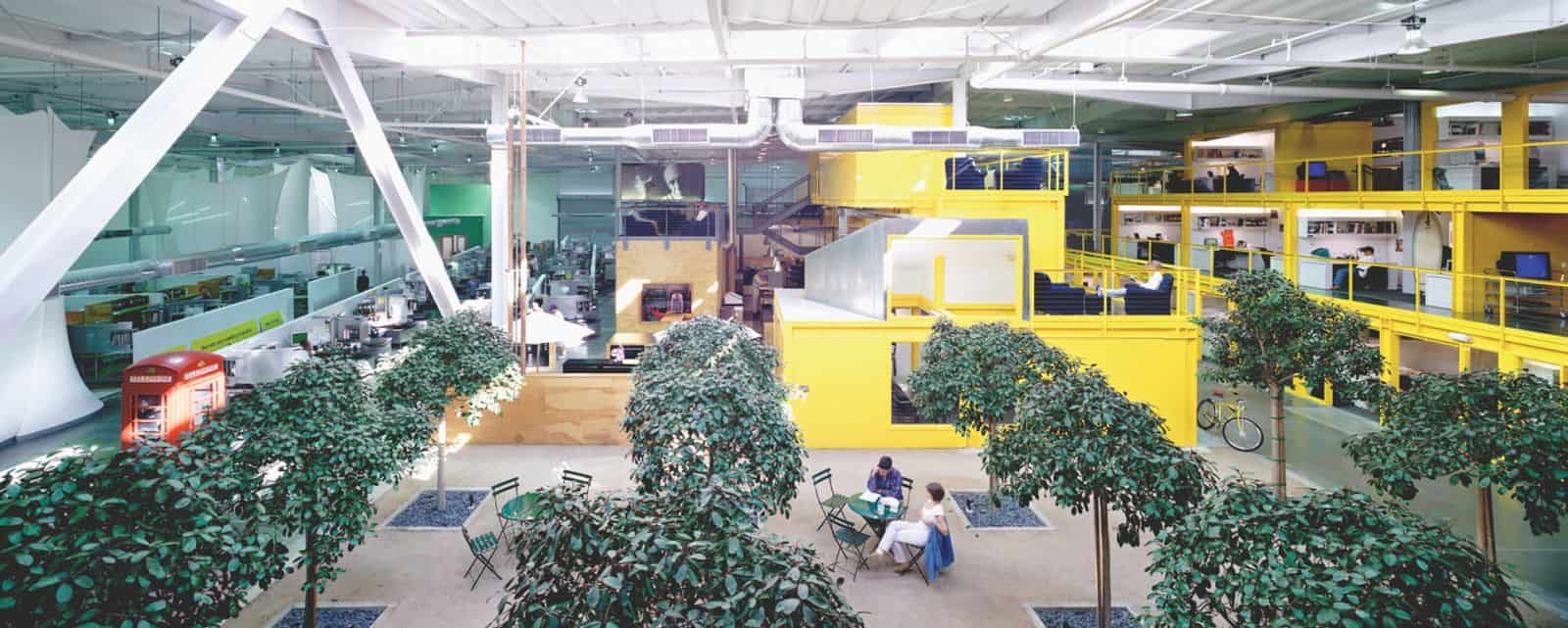Individuals spend more hours at work than they do at home or elsewhere. A sustainable work environment makes a long workday less stressful and more enjoyable for workers. Companies have crucial roles to play in this regard. This is not because they are the major contributors to global warming or environmental pollution, but they have the capabilities in form of incentives and opportunities to design innovative ideas in reversing what damages our ecosystem. This could be in form of investing renewable energy sources and the implementation of sustainable initiatives in the work environment.
So, what is a Sustainable Workplace? A sustainable workplace established the goal of balancing the planet, people, and profit to produce success and viability in the long-term. What this means is a business will be regarded as unsustainable if it fails to safeguard the health, safety, and welfare of their most cherished asset-employees.
A sustainable and healthy workplace produce happier and motivated workers, which eventually increase employee productivity and fewer work-related hazards, illnesses, and mishaps. This is fundamental to boosting the overall revenue and reputation of the organization.
Is a sustainable Workplace beneficial?

Some individuals usually dismiss the concept of a sustainable work environment as a hallucination or wishful thinking. The expectation of every business, after all, is to maximize profits for all stakeholders. Paying minimum wages, open offices, shifting schedules- these are few endeavors embarked by companies to minimize expenses and, significantly, maximize profits. If we go by a conventional approach, a company-sponsored restaurant serving expensive, yet healthy salads and low-fat chilled yogurt, or retail business to increases the wages of three million workers by $2 per hour.
A significant number of enterprises are becoming aware of the benefits of a sustainable work environment and its long-term profitability. Installing skylights and swapping to T5 fluorescent lighting connotes a reduction in electricity bills. Utilizing passive cooling and heating, and motivating workers to dress smartly for the season( compared to setting the air conditioner at 68°F/20°C throughout the year can generate the same outcomes. Higher worker productivity can be realized by providing healthier food in the workplace cafeteria as a result of increased energy level. (We also shared other factors that can improve employee productivity in this article – 100 Ways to be Productive at Work )
)
Impact of Sustainable Workplace on Market Value
Recent research has shown that businesses who invest in a sustainable work environment perform better compared to those who are passive about it. The 2008 unit’s report of Economic Intelligence Doing Good: Business and the Sustainability Challenge shows that there is a significant correlation between corporate social responsibility and stock performance. The research surveyed 1,254 senior corporate executives and affirmed that businesses that prioritized sustainability issues experienced the highest share-value growth from 2005 to 2007. On the other hand, the companies that were passive or paid less attention to sustainability issues performed poorly. (Check out OSW related video – Sustainability for Profit with stok (How investing in sustainability and wellness can improve workplace productivity, efficiency, and ultimately increase profits.
shows that there is a significant correlation between corporate social responsibility and stock performance. The research surveyed 1,254 senior corporate executives and affirmed that businesses that prioritized sustainability issues experienced the highest share-value growth from 2005 to 2007. On the other hand, the companies that were passive or paid less attention to sustainability issues performed poorly. (Check out OSW related video – Sustainability for Profit with stok (How investing in sustainability and wellness can improve workplace productivity, efficiency, and ultimately increase profits. )
)
A rise in stakeholder vigilance has also contributed to the connection between CSR performance and stock performance. Web 2.0 and its collaborative platforms have ensured companies all over the world are held accountable for sustainability issues. Recent instances include YouTube videos educating and alerting consumers about identified undesirable corporate practices. This has provided stakeholders with information of companies they should invest in or not to invest in.
Enhanced Talent Recruitment and Retention

Hill+Knowlton forecasted that the Millennials(1976-2001) would make up for about 75% of the total workforce by 2025. It is imperative for companies to adjust their culture and policies to attract not only millennials but also retain them. Millennials are looking for opportunities that will enable them to make a difference in their respective community.
Compared to previous generations, where the priority is power, money, and prestige, Millennials would instead work for a cause they believe in. For instance, the 2014 Millennial Impact Report  of the Case Foundation
of the Case Foundation and Achieve
and Achieve had 50% of Millennials responded that they would consider working in an organization that prioritizes involvement in various causes than the passive ones when searching for jobs. Direct purposes such as making clean water available to drought-stricken countries in East Africa or providing soft loans to less privileged women in Bangladesh could sound bogus; companies can establish goals such as dedication to corporate social responsibility or a motivation to significantly support workers.
had 50% of Millennials responded that they would consider working in an organization that prioritizes involvement in various causes than the passive ones when searching for jobs. Direct purposes such as making clean water available to drought-stricken countries in East Africa or providing soft loans to less privileged women in Bangladesh could sound bogus; companies can establish goals such as dedication to corporate social responsibility or a motivation to significantly support workers.
Integrating CSR into business operations, for instance, building a sustainable work environment may seem like a waste of resources at the beginning, but it will surely pay off in the long term. This will help companies to employ new individuals and retain the existing productive employees. In simple terms, a sustainable work environment saves a considerable sum of money spent on recruiting, selection, compensation, benefits, and many more.
Greater Consumer Confidence
A company’s stand on sustainability also plays an essential role for consumers. The 2006 Cone Millennial Cause Study discovered that 69% of respondents factor in a firm’s social and environmental stand when making a buy decision. Also, 45% of respondents, they may boycott the products or services offered by the company that is passive or irresponsible to social and environmental sustainability.
discovered that 69% of respondents factor in a firm’s social and environmental stand when making a buy decision. Also, 45% of respondents, they may boycott the products or services offered by the company that is passive or irresponsible to social and environmental sustainability.
To bolster this study, the most progressing enterprises among consumers in these present days are the few that prioritize ‘sustainability.’
Increased Revenue, Profit and Efficiency
A sustainable work environment boosts employee productivity just like we buttressed in this article titled, “25 Factors That Affect Workers Productivity (How do YOU Compete?)”
Provision of healthier foods can lower the risk of developing lifestyle-induced diseases like heart disease, diabetes, and cancer. The integration of Health and Safety precautions into day-to-day business operations such as proper waste management and the installations of railings on stairs can lessen the possibilities of accidents and injuries.
An unsustainable workplace is costly on its own, so it does not make sense not prioritizing sustainability. Millions of employees have been estimated to die as a result of diseases and occupational accidents. The direct and the indirect cost in the form of medical expenses, worker’s compensation, and lost working time amount to trillions of dollars.
Increased Business Activity
Businesses need natural resources to remain in business. Water is essential for factories to produce, and farms cannot thrive without fertile earth to till. Creating a sustainable workplace guarantees continuation in business activity by saving or renewing natural resources. More goods and services can be generated and provided in the future with more natural resources.
Concepts for creating a Sustainable Work Environment

Here are some ideas that businesses can adapt to create a sustainable workplace:
1. Electronics Management: There are lots of best practices that can be implemented to reduce energy consumption, and also cost. You can place stickers close to office machinery and light switches informing workers to switch them off when not in use. Motion sensors or automatic timers can as well be installed. Also, perform regular cleaning and repair of office equipment. Do you know that dirty or poorly kept machine consumes more energy than well maintained and clean ones? Laptops can also replace desktop computers as they are energy efficient. Substitute old machinery and appliances with new and energy-efficient pieces of equipment.
2. Sustainable Dining: Stock your vending machines and restaurants with healthier food instead of processed and caffeinated drinks. Cafeteria officials can be advised and encouraged to use reusable dishware instead of Styrofoam and plastic containers.
3. Virtual Conferences: Instead of planning face-to-face meetings with customers or partners, you can hold webinars. This saves effort, time, and other resources (for instance, gasoline, electricity, and water, etc.). It also ensures inclusion for more attendees, especially if the location has always been an impediment.
4. Workplace Wellness: Exercise programs during the workday can be incorporated into an employee schedule. This will impact their health and also make them more productive. A no-smoking corporate policy in the work environment can be implemented and enforced if it is not already regulated by the government. Information drive as touching tobacco cessation can also be established. Motivate workers to use the stairs instead of the escalator or elevator. Permit workers to use a standing desk to create an ergonomic workplace. Provide incentives for bicycling, taking public transportation, and carpooling. We wrote a detailed article titled, “ How do you promote wellness in the workplace? And our article titled, “Office Design For Productivity and Why it Matters!!”
And our article titled, “Office Design For Productivity and Why it Matters!!” provides insight into workplace ergonomics.
provides insight into workplace ergonomics.
5. Green Purchasing: Where suitable, make greener shopping by leasing or renting machinery instead of purchasing them. This means less consumption of natural resources and the reduction in production. If possible, buy second-grade equipment that is still energy efficient and in good condition. Motivate workers to recycle and educate on what items need to be dropped in the bins. You can create a customized bin for plastic and polythene. Also, purchase eco-friendly paints, office supplies, cleaning products, furnishings, and décor. This can positively produce quality air and prevent sicknesses. Companies can also purchase standing desks. We already provided a detailed review in our article, “37 Benefits of Standing Desk – #17 & #18 Convinced Me.”
6. Sustainable Supply Chain: Employing a sustainable supply chain is a fundamental approach to guaranteeing overall business sustainability. It may seem a long-term task, design your supply chain to point out unsustainable processes and how they can be improved. Collaborate with vendors to motivate and incentivize business practices that are considered sustainable. Incorporate sustainability as one of the criteria for selecting new suppliers. Utilize raw materials and avoid raw materials with hazardous substances like mercury, lead, and cadmium. As possible as you can, use recycled materials.
Conclusion
Investment in creating a sustainable work environment should be classified as one that will profit your organization more in the long term. This could be in the form of abundant natural resources and enhanced employee productivity. The successful companies are forward-thinking, and the future businesses will be those that prioritize workplace sustainability.
productivity. The successful companies are forward-thinking, and the future businesses will be those that prioritize workplace sustainability.
Related Questions
What are the advantages of creating a sustainable workplace? A sustainable and healthier workplace result in a stress-free and happier workers, which consequentially, enhances employee wellness and productivity.
How can companies create a sustainable workplace? A company can establish a sustainable culture such as recycling, reducing electricity bills, and caring about their employees, customer, and the earth.

